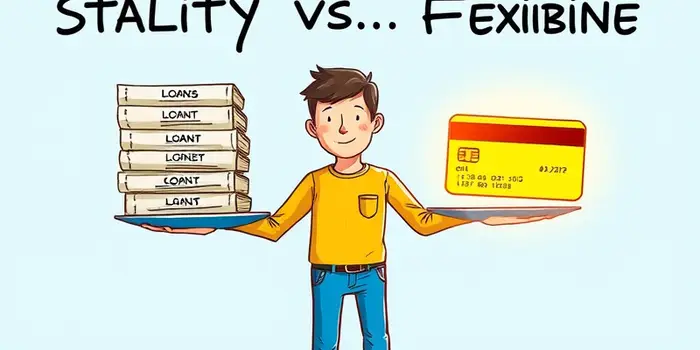
Choosing between a personal loan and a credit card can shape your financial journey. Understanding the nuances can help you decide which option aligns with your goals and budget.
At first glance, personal loans and credit cards might seem interchangeable. In reality, they serve distinct purposes and come with unique structures. A personal loan provides a lump sum borrowed at once and is repaid over a set timeframe, typically one to seven years. Borrowers benefit from fixed interest rates and scheduled payments, which instill discipline and clarity in financial planning.
Credit cards, in contrast, function as a revolving line of credit. You can borrow up to a preset limit repeatedly, paying back the balance or minimum amount each month. While this flexibility is useful for everyday expenses, the variable interest rates can create unpredictability if balances carry over.
Interest rates largely determine the total cost of borrowing. In 2024-2025, personal loan APRs typically range from 5.99% to 35.99%, with consumers boasting excellent credit often securing rates between 12.43% and 18.68%. By contrast, credit card APRs span from approximately 13.24% to over 24.72%, with an average in the 20.12% to 24.72% bracket. This gap can translate into significant savings over the loan term when choosing a personal loan for larger sums.
One of the strongest appeals of personal loans is a transparent and predictable payment schedule. Borrowers know exactly how much is due each month, simplifying budgeting and reducing the risk of missed payments. This structure also ensures a clear end date, which can provide peace of mind and motivate timely repayment.
On the flip side, credit cards offer a minimum payment system, which may tempt cardholders to pay less than the full balance. While this can aid short-term cash flow, it often leads to revolving debt. Carrying balances month after month escalates interest expenses, making it harder to clear what you owe.
Both personal loans and credit cards influence your credit profile differently. Personal installment loans can diversify your credit mix, and a history of on-time payments can boost your credit score over time. However, loan origination may involve a hard inquiry, causing a slight, temporary dip in your score.
Credit cards directly affect your utilization rate—the ratio of your card balances to credit limits. High utilization can signal risk to lenders, potentially lowering your score. Keeping balances below 30% of your available credit is a key strategy for maintaining a healthy credit profile.
Opting for a personal loan may be the superior choice when:
You need to borrow a large sum of money at once and desire a structured repayment plan.
Consolidating multiple high-interest credit card balances could significantly reduce your total interest outlay.
Having a set debt-free target date is important to you, as loans come with a fixed payoff schedule.
Continued access to credit isn’t necessary, minimizing temptation and potential overspending.
Borrowers with very low credit scores may face high APRs on both products, narrowing the gap between loan and card costs. In these cases, evaluating the total interest charges over time can reveal which option yields the least expense.
Balance transfer cards offering 0% APR for 12 to 18 months might outshine personal loans if you’re confident you can eliminate the debt before the promotional period ends. Always calculate the potential post-promo rate to avoid surprises and higher costs.
Before finalizing any borrowing decision, it’s important to account for all associated costs. Personal loans often carry origination fees, which may reduce the net funds you receive. Conversely, many credit cards charge annual fees, foreign transaction fees, and balance transfer fees. Some cards even impose cash advance fees, making that option among the most expensive forms of credit.
Promotional card offers with introductory APR periods might seem attractive, but the rates can skyrocket after the promotion ends. Similarly, loans with prepayment penalties can limit your ability to pay off debt early and save on interest.
Deciding between a personal loan and a credit card hinges on your unique financial needs, repayment discipline, and long-term goals. A personal loan’s predictable repayment plan and potential cost savings make it ideal for larger, planned expenses or consolidation projects. Credit cards, on the other hand, offer flexible access to funds and valuable rewards for routine spending and emergencies.
By carefully evaluating interest rates, fees, repayment structures, and your own spending habits, you can confidently select the option that best supports your financial well-being. Armed with this knowledge, you’re one step closer to mastering your debt strategy and achieving financial freedom.
References













